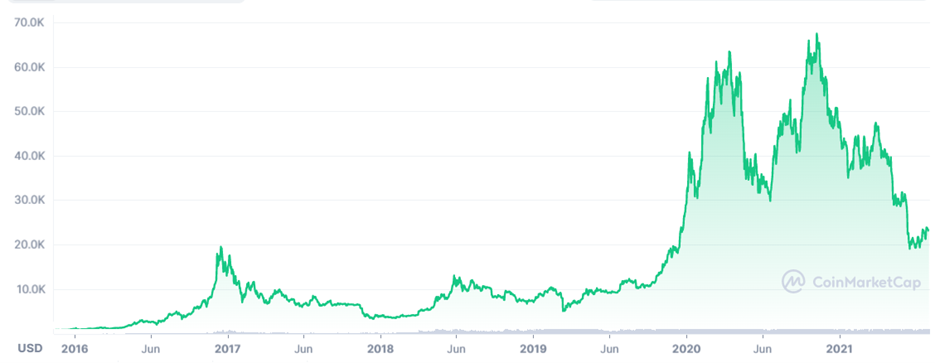Economics Faculty Research Discussion
Crypto Volatility by Prof. Warren Anderson
September 2022
Cryptocurrency frequently makes the news on large price increases and declines. Bitcoin’s path since early 2017 has been wild: below $1000, peaked shy of $20,000, crashed to roughly $3500, then back up to $12,000, down to $6,000, clear up to $60,000, down to $32,000, reached $65,000, down to $19,000 and now is around $24,000. Such wild swings can be viewed as a great deterrent for entry and makes one wonder how such volatility is possible.

One explanation for the volatile crypto market is the Trilemma from monetary theory. It states that a country can only choose two of the following three options:
- A fixed (stable) exchange rate (XR)
- Free capital flows
- Independent monetary policy (MP)
A fixed exchange rate is when one currency is pegged to another at a set rate. This compares to a floating rate, where currency values fluctuate. Capital flows are when money can freely move in and out of a country. Independent MP has various definitions, but here I will define it as central bankers can choose interest rates based on the state of the economy.
We can look at this with America. We have relatively free capital flows, which will cause our XR to move. The Fed is free to choose interest rates based on the state of the economy/inflation, which likewise will cause the XR to fluctuate. Given this, our exchange rate has to be free floating.
As a comparison, we can look at China. From 1995 to 2005 the yuan had a strict peg to the dollar. Yet the Chinese central bank had independent monetary policy. This is because of very strict capital flows; the Chinese government makes it extremely difficult to move money in or out of the country. With no external monetary movement, the Chinese central bank could fix the exchange rate abroad and have independent MP domestically.
Hong Kong gives a different route. They have a pegged exchange rate and allow for capital flows. This means the Hong Kong central bank cannot dictate monetary policy. Their central bankers must use MP to react to money moving in and out of the country and balance that with pressures on their exchange rate.
One point to mention is that if the exchange rate in America changes too drastically, the Fed can intervene in foreign exchange markets to either have the dollar appreciate or depreciate. So while the dollar is freely floating, it is not completely unpegged as some intervention can happen – you trade off some independence of MP for a more stable XR.
This brings us back to cryptocurrency. Looking just at bitcoin, the monetary policy is completely independent of any intervention. Satoshi Nakamoto – its creator – dictated that the money supply will increase at a predetermined rate until 21 million bitcoin are made. This is as independent MP as one can have; it is literally programmed into the system and will not react to any outside forces. Furthermore, a major premise of bitcoin and crypto in general is free flowing capital. With no centralized third party, anyone can move their crypto anywhere at any time.
Given that bitcoin is the currency with perhaps the most independent MP and freest capital flows, it should not be surprising that the exchange rate with the dollar is unbelievably volatile. Complete MP independence means Satoshi will not intervene to smooth the fluctuations as it is impossible. Likewise, no one can stop bitcoin from moving around the world. Looking at crypto through the lens of the trilemma, we can view the mass fluctuation of prices as a feature, not a bug. If you allow independence in two spheres, as bitcoin was designed, then the tradeoff is extreme fluctuations. Whether or not you want to invest in crypto is up to the individual, but just know economic theory dictates volatility which is exactly what we see.
Department of Social Sciences
4901 Evergreen Road
Dearborn, MI 48128
View on Map
